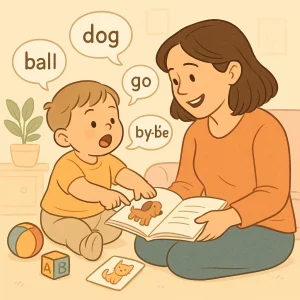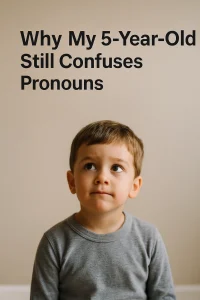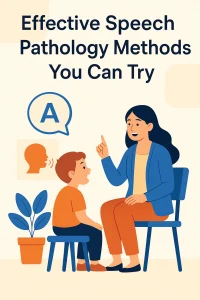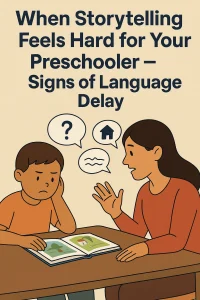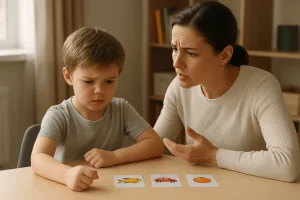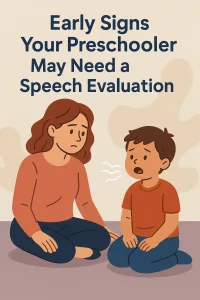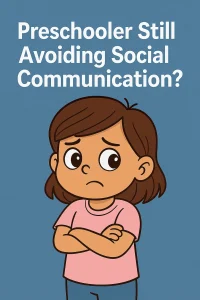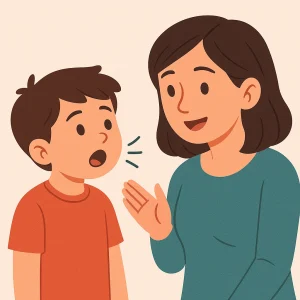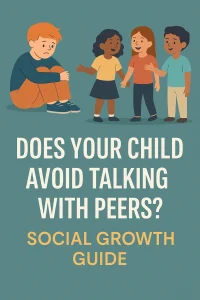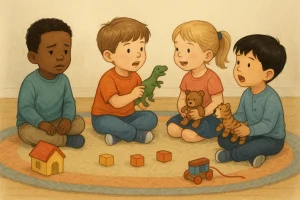Articulation Therapy for Kids: Perfecting the ‘Z’ Sound
Last Updated: August 5, 2024
Clear and effective communication is essential for children as it enables them to share their thoughts and build connections. Mastering the ‘Z’ sound, often dubbed the buzzing bee sound, is crucial yet challenging for many young speakers. This sound, prevalent in countless everyday words, enhances clarity and precision in a child’s speech. Perfecting it demands coordinated mouth muscle movements and vocal cord vibrations—skills that don’t always come naturally to kids. Without the right approach and ample patience, mastering this sound can be a source of frustration for both children and their parents, emphasizing the need for targeted and supportive speech techniques.
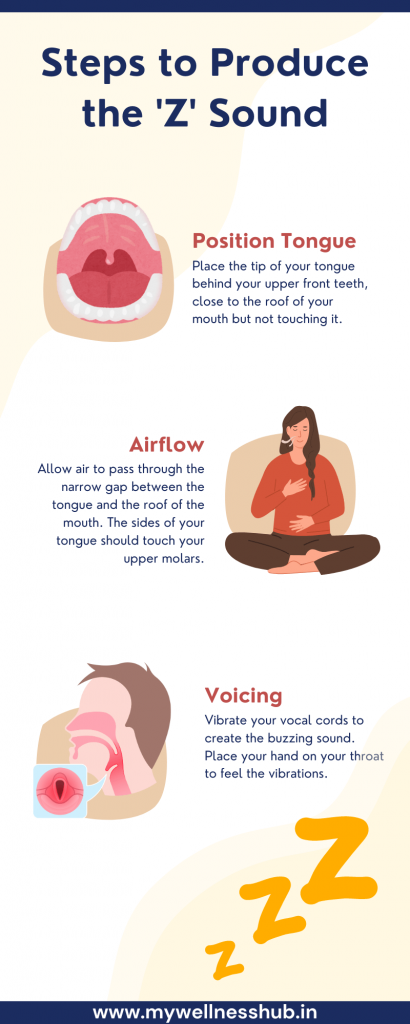
Understanding the ‘Z’ Sound
Articulation therapy for kids often focuses on helping them master challenging sounds, and the ‘Z’ sound is no exception. This sound is essential for clear communication and appears in many everyday words. Let’s explore the mechanics of the ‘Z’ sound and how it differs from the ‘S’ sound, which can help in understanding and teaching this tricky articulation.
Mechanics of the ‘Z’ Sound
The ‘Z’ sound, often referred to as the buzzing bee sound, requires the coordination of several parts of the mouth and throat. Here’s how you can break it down for your child:
- Voicing: The ‘Z’ sound is a voiced consonant. This means that when you produce the sound, your vocal cords should vibrate. You can feel this vibration by placing a hand on your throat while saying “zzz.”
- Tongue Placement: The tongue plays a crucial role in making the ‘Z’ sound. Place the tip of your tongue just behind your upper front teeth, close to but not touching the roof of your mouth. The sides of your tongue should touch the upper molars, creating a narrow channel for the air to pass through.
- Airflow: For the ‘Z’ sound, the airflow is continuous and unbroken. The air moves through the narrow gap between the tongue and the roof of the mouth while the vocal cords vibrate, producing the buzzing sound.
Comparing ‘Z’ and ‘S’ Sounds
Understanding the differences and similarities between the ‘Z’ and ‘S’ sounds can be incredibly helpful in articulation therapy for kids:
- Similarities: Both sounds use the same mouth position. The tongue placement and the airflow path are identical for ‘Z’ and ‘S’. This similarity can make it easier for children to transition from one sound to the other.
- Differences: The key difference lies in voicing. The ‘S’ sound is unvoiced, meaning the vocal cords do not vibrate. To illustrate this, have your child place their hand on their throat and produce the ‘S’ sound (“sss”) followed by the ‘Z’ sound (“zzz”). They should notice the vibration only with the ‘Z’ sound.
By understanding these mechanics, you can guide your child through effective articulation exercises. Practicing these sounds with clear instructions and fun activities can make a significant difference in their speech clarity.
Comparison of ‘Z’ and ‘S’ Sounds
| Aspect | ‘Z’ Sound | ‘S’ Sound |
|---|---|---|
| Voicing | Voiced (vocal cords vibrate) | Unvoiced (no vocal cord vibration) |
| Tongue Placement | Tip behind upper front teeth, close to but not touching the roof of the mouth | Tip behind upper front teeth, close to but not touching the roof of the mouth |
| Airflow | Continuous airflow through a narrow gap while vocal cords vibrate | Continuous airflow through a narrow gap without vocal cord vibration |
| Example Words | “zoo,” “buzz,” “zip” | “see,” “bus,” “sip” |
| Tactile Feedback | Feel throat vibrations when producing the sound | No vibrations felt in the throat |
| Sound Association | Often associated with buzzing like a bee | Often associated with hissing like a snake |
Also Read: What is the Relation between Communication, Speech and Language? | Speech and Language Therapy
Common Challenges with the ‘Z’ Sound
When it comes to child speech therapy, certain challenges can make it difficult for kids to master the ‘Z’ sound. Understanding these common issues can help you address them effectively during children’s articulation exercises and kid’s speech correction sessions.
Frontal and Lateral Lisps
Lisps are common speech disorders that can affect a child’s ability to produce the ‘Z’ sound correctly. There are two main types of lisps:
- Frontal Lisp: This occurs when a child produces the ‘Z’ sound with their tongue too far forward, often pushing it between their teeth. This can make the ‘Z’ sound more like a ‘TH’. A frontal lisp can develop from prolonged thumb-sucking or using a sippy cup. To correct this, encourage your child to place their tongue just behind their upper front teeth without pushing it forward.
- Lateral Lisp: A lateral lisp happens when the air escapes over the sides of the tongue instead of through the center. This can make the ‘Z’ sound “slushy.” Children with a lateral lisp often struggle with saliva control when producing the sound. Using visuals and tactile cues can help them adjust their tongue position to correct this.
Also Read: 6 Varieties of Lisps and How to Overcome Them
Phonological Process of Stopping
Another common challenge is the phonological process known as stopping. This occurs when a child replaces a fricative sound like ‘Z’ with a stop consonant like ‘D’. For example, they might say “doe” instead of “zoo.” Stopping is a typical pattern in young children’s speech development but usually resolves by age 3½.
If your child continues to use stopping beyond this age, it might affect their ability to produce the ‘Z’ sound correctly. To address this, focus on exercises that emphasize the difference between fricative and stop sounds. For instance, have your child practice transitioning from ‘D’ to ‘Z’ by starting with the ‘D’ sound and stretching it into a ‘Z’.
Addressing these Challenges
To effectively help your child overcome these challenges, incorporate a variety of techniques into their speech therapy routine. Use visual, verbal, and tactile cues to guide them in producing the correct sound. Engage in fun, interactive exercises to keep them motivated and make learning enjoyable.
Common Lisp Types and Solutions
| Lisp Type | Description | Solution |
|---|---|---|
| Frontal Lisp | Tongue too far forward, often between teeth | Encourage correct tongue placement behind teeth |
| Lateral Lisp | Air escapes over the sides of the tongue, creating a “slushy” sound | Use visual aids to show correct tongue position and control airflow |
| Stopping | Replacing the ‘Z’ sound with a ‘D’ sound | Practice transitioning from ‘D’ to ‘Z’ sound with specific exercises |
Effective Techniques to Teach the ‘Z’ Sound
Teaching the ‘Z’ sound can be a fun and rewarding experience for both you and your child. Here are some effective articulation therapy techniques for kids to help them master this important sound.
Verbal Cues
Demonstrate the Sound Clearly and Slowly: One of the best ways to teach kids the ‘Z’ sound in speech therapy is through clear and slow demonstration. Start by modeling the ‘Z’ sound for your child. Say “/zzz/” slowly and clearly, allowing them to hear and see how the sound is produced. Repeat this several times, ensuring they can observe your mouth movements.
Practice with Syllables and Simple Words: Once your child understands the basic sound, move on to practicing with simple syllables and words. Start with syllables like “za,” “zo,” “zu,” and then progress to simple words such as “zoo,” “zip,” and “buzz.” This gradual progression helps reinforce their understanding and ability to produce the sound correctly.
Visual Cues
Use Mirrors and Visual Aids to Show Tongue and Mouth Placement: Visual aids can significantly enhance your child’s learning experience. Using a mirror, have your child watch their mouth movements while producing the ‘Z’ sound. Show them how to position their tongue and lips correctly. This helps them visualize the proper placement and movement needed for the sound.
Incorporate Fun Activities Like “Buzzzzing” Around Like Bees: Make learning the ‘Z’ sound enjoyable by incorporating playful activities. For example, pretend to be bees and buzz around the room together, saying “zzz” as you go. This not only makes practice fun but also reinforces the correct production of the sound in a memorable way.
Tactile Cues
Have Children Feel the Vibrations in Their Throat to Distinguish Between ‘S’ and ‘Z’ Sounds: Tactile cues are an excellent way to help children differentiate between the ‘S’ and ‘Z’ sounds. Have your child place their hand on your throat while you say “zzz” so they can feel the vibrations. Then, let them do the same with their own throat while producing the sound. This tactile feedback helps them understand the difference between the voiced ‘Z’ and the unvoiced ‘S’.
Making Progress with Consistent Practice
Regular practice using these techniques can greatly improve your child’s ability to articulate the ‘Z’ sound. Remember, patience and encouragement are key. Celebrate small successes along the way to keep your child motivated and engaged.
Fun and Engaging Activities
Articulation therapy for kids can be a fun and interactive process, especially when it includes engaging activities that make practicing the ‘Z’ sound enjoyable. Here are some awesome ‘Z’ activities and resources to help your child master this sound while having a great time.
Awesome ‘Z’ Activities
Buzzzzing Like Bees, Zzzzooming Like Race Cars Turn articulation practice into a game by incorporating movements and sounds kids love. Pretend to be bees and buzz around the room, saying “zzz” as you move. You can also zoom around like race cars, making the “zzzzoom” sound. These activities not only make practice fun but also help children associate the ‘Z’ sound with enjoyable actions, reinforcing their learning through play.
Games Like “Freeze Me” to Practice the ‘Z’ Sound in Context Interactive games can make speech exercises more dynamic and effective. Try playing “Freeze Me,” where you use commands like “freeze” and “unfreeze” during the game. Every time your child hears the word “freeze,” they have to stop moving and say a word with the ‘Z’ sound, like “zebra” or “buzz.” This game helps practice the ‘Z’ sound in a fun, context-driven way, keeping your child engaged and focused.
Games and Resources
Interactive Games and Tools There are many interactive games and tools available that can make practicing the ‘Z’ sound more enjoyable. For instance, using apps and online games designed for speech therapy can provide a structured yet fun environment for practice. Subtly integrate these resources into your routine to keep your child motivated.
Tips for Parents and Speech Therapists
Helping a child master the ‘Z’ sound can be a collaborative effort between parents and speech therapists. Here are some practical tips to support your child’s progress, ensuring they receive consistent practice and guidance.
How Parents Can Support Practice at Home
- Consistency and Patience Are Key To help your child perfect the ‘Z’ sound, it’s crucial to practice regularly and be patient with their progress. Consistency helps reinforce learning and builds muscle memory. Set aside a few minutes each day for speech exercises, making it a fun and engaging part of your routine.
- Create a Positive Practice Environment Make speech practice enjoyable by incorporating fun exercises for kids to learn the ‘Z’ sound. Use activities like buzzing like bees or playing interactive games that emphasize the ‘Z’ sound. Praise your child for their efforts and celebrate small achievements to keep them motivated.
- Use Step-by-Step Guides and Visual Aids A step-by-step guide to perfecting the ‘Z’ sound in children can be incredibly helpful. Break down the sound into manageable parts: start with the basics of tongue placement and voicing, then move to syllables, words, and finally sentences. Utilize mirrors and visual aids to help your child see and understand the correct mouth positions.
Know more: The Importance of Consistency in Online Speech Therapy
Conclusion
Mastering the ‘Z’ sound takes time, but with patience and regular practice, your child will improve. Stay positive and celebrate small victories. Remind your child that making mistakes is part of learning and that each try brings them closer to success. Keep practicing, and progress will come.
For more help, check out Wellness Hub. We offer expert advice, fun games, and useful tools for speech therapy. A speech therapist can provide extra support if needed. Visit our Wellness Hub website for more resources. Keep practicing, stay positive, and use the resources at Wellness Hub to support your child’s journey.
Frequently Asked Questions:
1. What is articulation therapy for kids?
Articulation therapy for kids is a type of speech therapy that helps children learn how to pronounce sounds correctly. It involves exercises and activities designed to improve the clarity of speech by focusing on specific sounds like the ‘Z’ sound.
2. How can I teach my child the ‘Z’ sound at home?
To teach your child the ‘Z’ sound at home, start by demonstrating the sound clearly and slowly. Use verbal, visual, and tactile cues. Practice with simple syllables and words, and incorporate fun activities like pretending to be buzzing bees. Consistency and patience are key.
3. What are common challenges children face with the ‘Z’ sound?
Common challenges include frontal and lateral lisps, where the tongue placement is incorrect, and the phonological process of stopping, where children replace the ‘Z’ sound with a ‘D’ sound. These can be addressed with specific speech exercises and professional guidance if needed.
4. How can visual aids help in teaching the ‘Z’ sound?
Visual aids, like mirrors and pictures, help children see the correct tongue and mouth placement for the ‘Z’ sound. Watching their own mouth movements in a mirror can reinforce proper techniques and improve their ability to produce the sound.
5. What should I do if my child struggles with the ‘Z’ sound beyond age 8?
If your child continues to struggle with the ‘Z’ sound beyond age 8, it’s important to seek help from a speech therapist. They can provide specialized techniques and exercises tailored to your child’s needs.
6. Are there any fun activities to practice the ‘Z’ sound?
Yes, there are many fun activities to practice the ‘Z’ sound. Examples include buzzing like bees, zooming like race cars, and playing interactive games like “Freeze Me,” which incorporate the ‘Z’ sound in a playful context.
7. How can Wellness Hub support my child’s speech development?
Wellness Hub offers a variety of resources, including expert advice, interactive games, and speech therapy tools. Our platform provides valuable support for parents and children to improve speech clarity and address articulation challenges.
8. Why is the ‘Z’ sound important for clear speech?
The ‘Z’ sound is important for clear speech because it appears in many common words. Proper articulation of this sound ensures that children can communicate effectively and be understood by others.
9. What is the difference between the ‘Z’ sound and the ‘S’ sound?
The ‘Z’ sound is voiced, meaning the vocal cords vibrate when producing it, while the ‘S’ sound is unvoiced. Both sounds have the same mouth and tongue placement, but the vibration differentiates them.
10. How often should we practice the ‘Z’ sound?
Regular daily practice is ideal for mastering the ‘Z’ sound. Short, consistent practice sessions are more effective than infrequent, longer sessions. Keep the practice fun and engaging to maintain your child’s interest.
About the Author:
Anuradha Karanam
Speech-language pathologist (7+ years of experience)
Anuradha Karanam is a skilled speech-language pathologist with over 6 years of experience. Fluent in Tamil, Telugu, Hindi, and English, she specializes in parent counseling, speech sound disorders, fluency assessment, and speech-language evaluations. Anuradha excels at working with children with developmental disorders, offering creative and effective therapy programs. Currently at Wellness Hub, she holds a BASLP degree and is registered with the RCI (CRR No A85500). Her patience, ambition, and dedication make her a trusted expert in her field.
Book your Free Consultation Today
Parent/Caregiver Info:
Client’s Details:
* Error Message
